Page 414 of 650

414 4-3. Do-it-yourself maintenance
CAUTION
The engine compartment contains many mechanisms and fluids that may
move suddenly, become hot, or become electrically energized. To avoid death
or serious injury, observe the following precautions.
When working on the engine compartment
Keep hands, clothing, and tools away from the moving fan and engine
drive belt.
Be careful not to touch the engine, radiator, exhaust manifold, etc. right
after driving as they may be hot. Oil and other fluids may also be hot.
Do not leave anything that may burn easily, such as paper or rags, in the
engine compartment.
Do not smoke, cause sparks or expose an open flame to fuel or the bat-
tery. Fuel and battery fumes are flammable.
Be extremely cautious when working on the battery. It contains poisonous
and corrosive sulphuric acid.
Take care because brake fluid can harm your hands or eyes and damage
painted surfaces.
If fluid gets on your hands or in your eyes, flush the affected area with
clean water immediately.
If you still experience discomfort, see a doctor.
When working near the electric cooling fan or radiator grille
Vehicles without smart entry & start system: Be sure the engine switch is
in the “LOCK” position.
With the engine switch in the “ON” position, the electric cooling fan may
automatically start to run if the air conditioning is on and/or the coolant
temperature is high. (P. 433)
Vehicles with smart entry & start system: Be sure the “ENGINE START
STOP” switch is off.
With the “ENGINE START STOP” switch in IGNITION ON mode, the elec-
tric cooling fan may automatically start to run if the air conditioning is on
and/or the coolant temperature is high. (P. 433)
Safety glasses
Wear safety glasses to prevent flying or falling material, fluid spray, etc. from
getting in the eyes.
VERSO_WE.book Page 414 Thursday, June 19, 2014 11:31 AM
Page 424 of 650
424 4-3. Do-it-yourself maintenance
Engine oil
With the engine at operating temperature and turned off, check the oil
level on the dipstick.
Checking the engine oil
Park the vehicle on level ground. After warming up the engine
and turning it off, wait more than 5 minutes for the oil to drain
back into the bottom of the engine.
Hold a rag under the end and pull the dipstick out.
Gasoline engine (1ZR-FAE and 2ZR-FAE engines)
Diesel engine (1AD-FTV and 2AD-FHV engines)
VERSO_WE.book Page 424 Thursday, June 19, 2014 11:31 AM
Page 527 of 650
5
527 5-2. Steps to take in an emergency
When trouble arises
(Flashes)Indicates that the
parking brake is still
engaged.
A buzzer sounds to
indicate that parking
brake is still engaged
(with the vehicle hav-
ing reached a speed
of more than 5 km/h [3
mph]).Release the parking
brake.
*1Indicates that the Mul-
tidrive or automatic
transmission fluid
temperature is too
high.
A buzzer also sounds.Stop the vehicle in a
safe place and shift
lever to “P”.
If the light does not go
off, contact any autho-
rized Toyota dealer or
repairer, or another duly
qualified and equipped
professional.
*2
Indicates that engine
oil level is low.
A buzzer also sounds.Check the level of
engine oil, and add if
necessary.
(Flashes)Indicates that the
headlight switch is left
on (with the key
removed and the
driver’s door opened).
A buzzer also sounds.Turn the headlight
switch off.
Warning messageDetailsCorrection procedure
VERSO_WE.book Page 527 Thursday, June 19, 2014 11:31 AM
Page 607 of 650
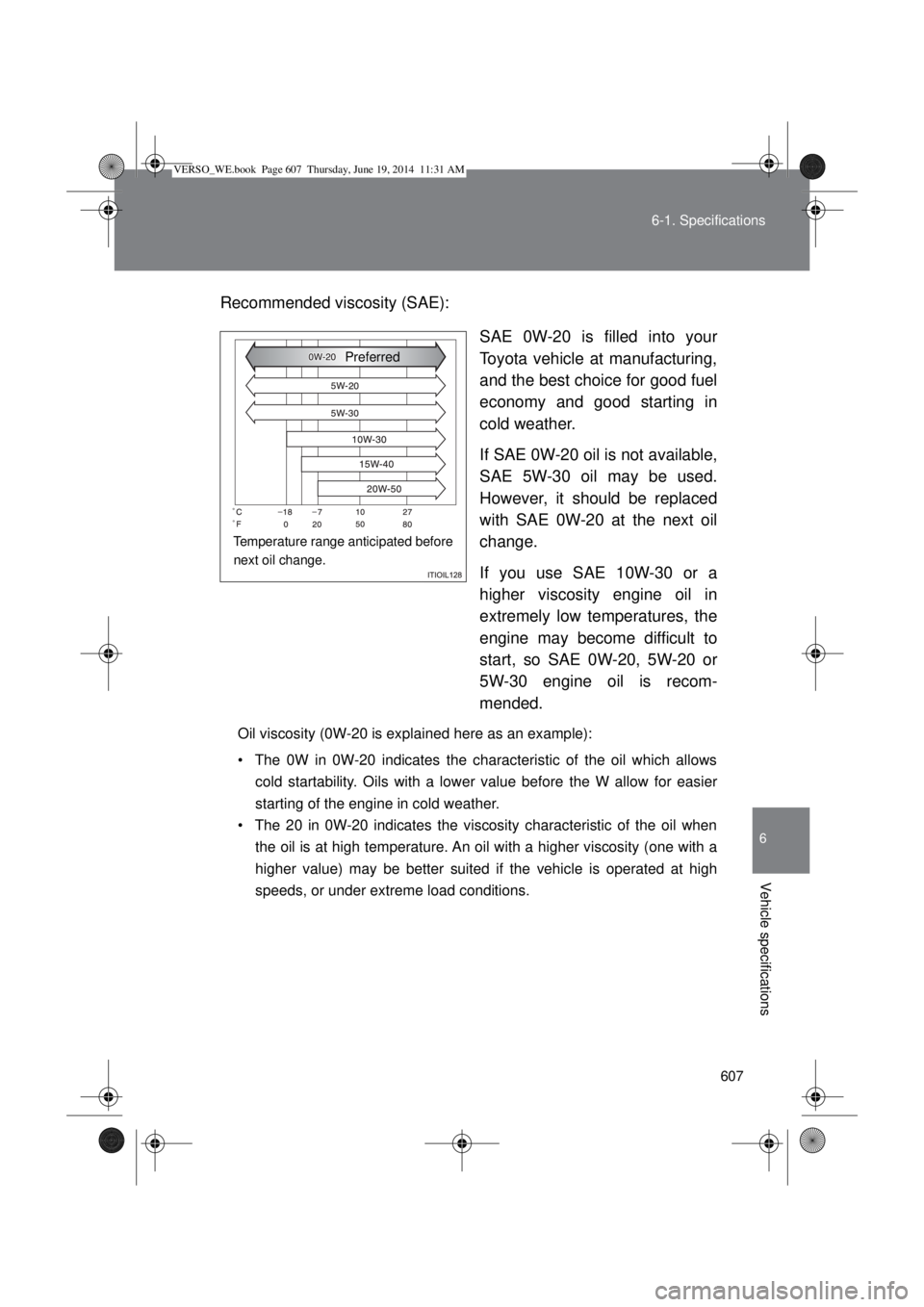
607 6-1. Specifications
6
Vehicle specifications
Recommended viscosity (SAE):
SAE 0W-20 is filled into your
Toyota vehicle at manufacturing,
and the best choice for good fuel
economy and good starting in
cold weather.
If SAE 0W-20 oil is not available,
SAE 5W-30 oil may be used.
However, it should be replaced
with SAE 0W-20 at the next oil
change.
If you use SAE 10W-30 or a
higher viscosity engine oil in
extremely low temperatures, the
engine may become difficult to
start, so SAE 0W-20, 5W-20 or
5W-30 engine oil is recom-
mended.
Oil viscosity (0W-20 is explained here as an example):
• The 0W in 0W-20 indicates the characteristic of the oil which allows
cold startability. Oils with a lower value before the W allow for easier
starting of the engine in cold weather.
• The 20 in 0W-20 indicates the viscosity characteristic of the oil when
the oil is at high temperature. An oil with a higher viscosity (one with a
higher value) may be better suited if the vehicle is operated at high
speeds, or under extreme load conditions.
Temperature range anticipated before
next oil change.Preferred
VERSO_WE.book Page 607 Thursday, June 19, 2014 11:31 AM
Page 609 of 650
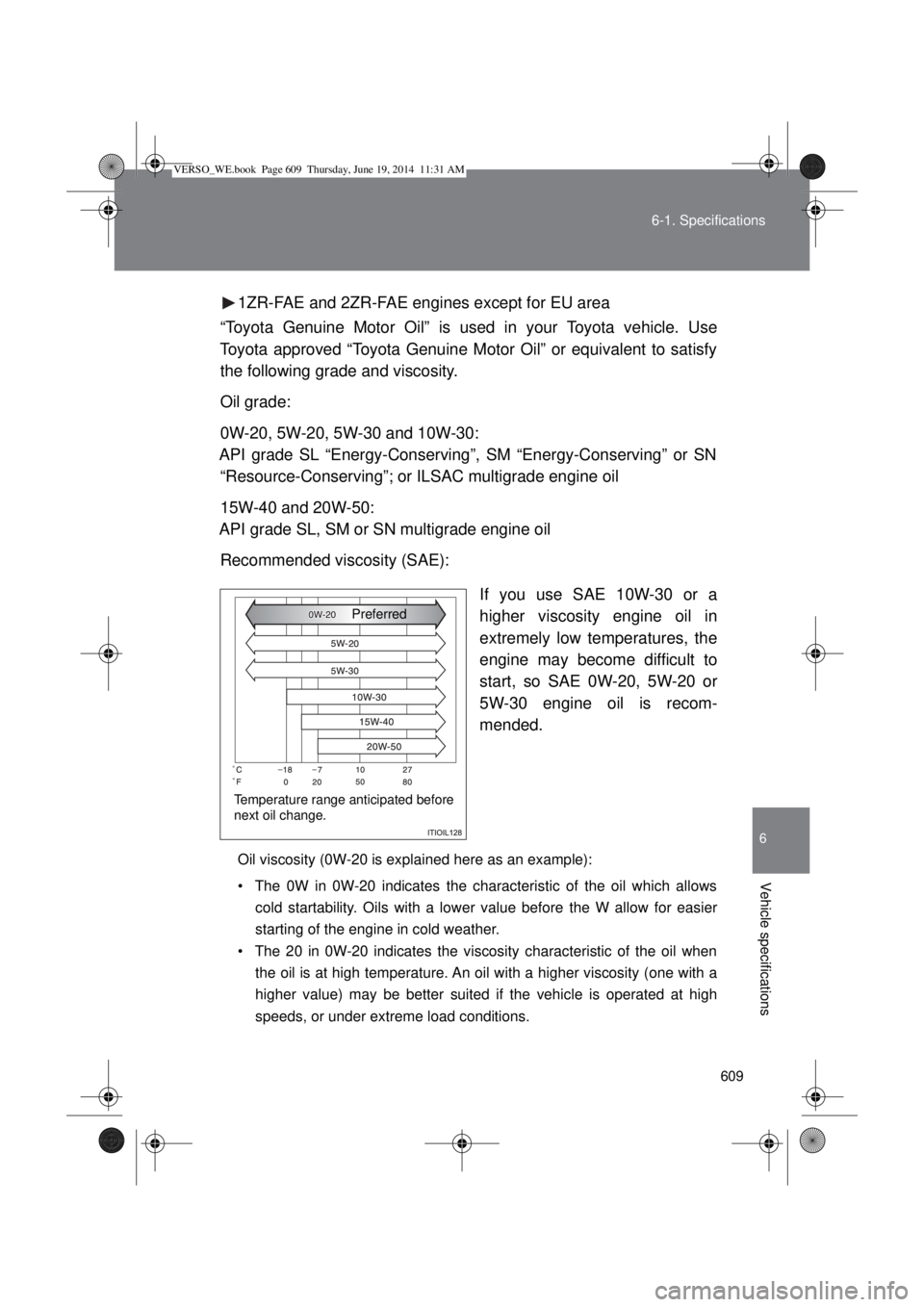
609 6-1. Specifications
6
Vehicle specifications
1ZR-FAE and 2ZR-FAE engines except for EU area
“Toyota Genuine Motor Oil” is used in your Toyota vehicle. Use
Toyota approved “Toyota Genuine Motor Oil” or equivalent to satisfy
the following grade and viscosity.
Oil grade:
0W-20, 5W-20, 5W-30 and 10W-30:
API grade SL “Energy-Conserving”, SM “Energy-Conserving” or SN
“Resource-Conserving”; or ILSAC multigrade engine oil
15W-40 and 20W-50:
API grade SL, SM or SN multigrade engine oil
Recommended viscosity (SAE):
If you use SAE 10W-30 or a
higher viscosity engine oil in
extremely low temperatures, the
engine may become difficult to
start, so SAE 0W-20, 5W-20 or
5W-30 engine oil is recom-
mended.
Oil viscosity (0W-20 is explained here as an example):
• The 0W in 0W-20 indicates the characteristic of the oil which allows
cold startability. Oils with a lower value before the W allow for easier
starting of the engine in cold weather.
• The 20 in 0W-20 indicates the viscosity characteristic of the oil when
the oil is at high temperature. An oil with a higher viscosity (one with a
higher value) may be better suited if the vehicle is operated at high
speeds, or under extreme load conditions.
Temperature range anticipated before
next oil change.Preferred
VERSO_WE.book Page 609 Thursday, June 19, 2014 11:31 AM
Page 611 of 650
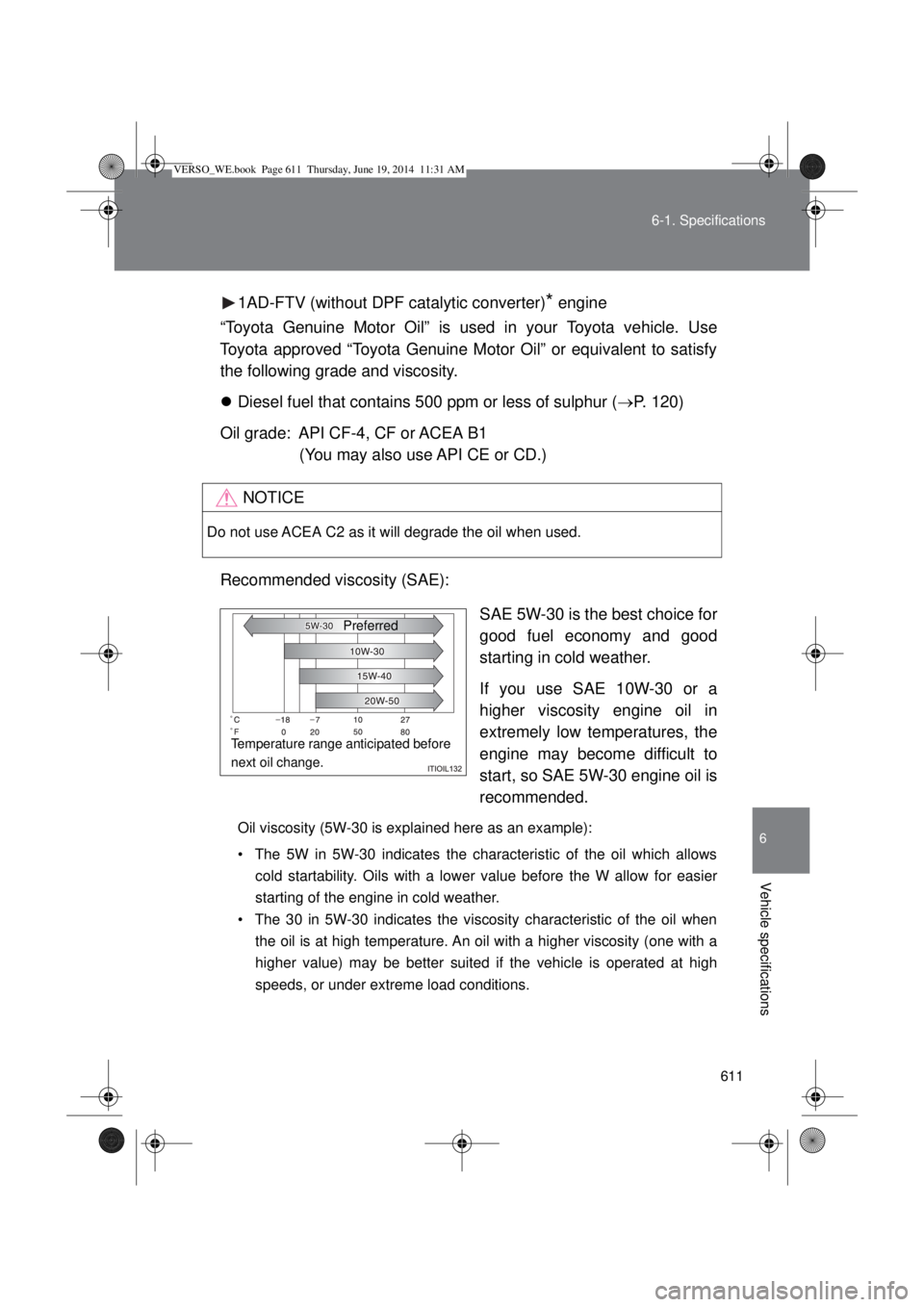
611 6-1. Specifications
6
Vehicle specifications
1AD-FTV (without DPF catalytic converter)* engine
“Toyota Genuine Motor Oil” is used in your Toyota vehicle. Use
Toyota approved “Toyota Genuine Motor Oil” or equivalent to satisfy
the following grade and viscosity.
Diesel fuel that contains 500 ppm or less of sulphur (P. 120)
Oil grade: API CF-4, CF or ACEA B1
(You may also use API CE or CD.)
Recommended viscosity (SAE):
SAE 5W-30 is the best choice for
good fuel economy and good
starting in cold weather.
If you use SAE 10W-30 or a
higher viscosity engine oil in
extremely low temperatures, the
engine may become difficult to
start, so SAE 5W-30 engine oil is
recommended.
Oil viscosity (5W-30 is explained here as an example):
• The 5W in 5W-30 indicates the characteristic of the oil which allows
cold startability. Oils with a lower value before the W allow for easier
starting of the engine in cold weather.
• The 30 in 5W-30 indicates the viscosity characteristic of the oil when
the oil is at high temperature. An oil with a higher viscosity (one with a
higher value) may be better suited if the vehicle is operated at high
speeds, or under extreme load conditions.
NOTICE
Do not use ACEA C2 as it will degrade the oil when used.
Temperature range anticipated before
next oil change.Preferred
VERSO_WE.book Page 611 Thursday, June 19, 2014 11:31 AM
Page 612 of 650
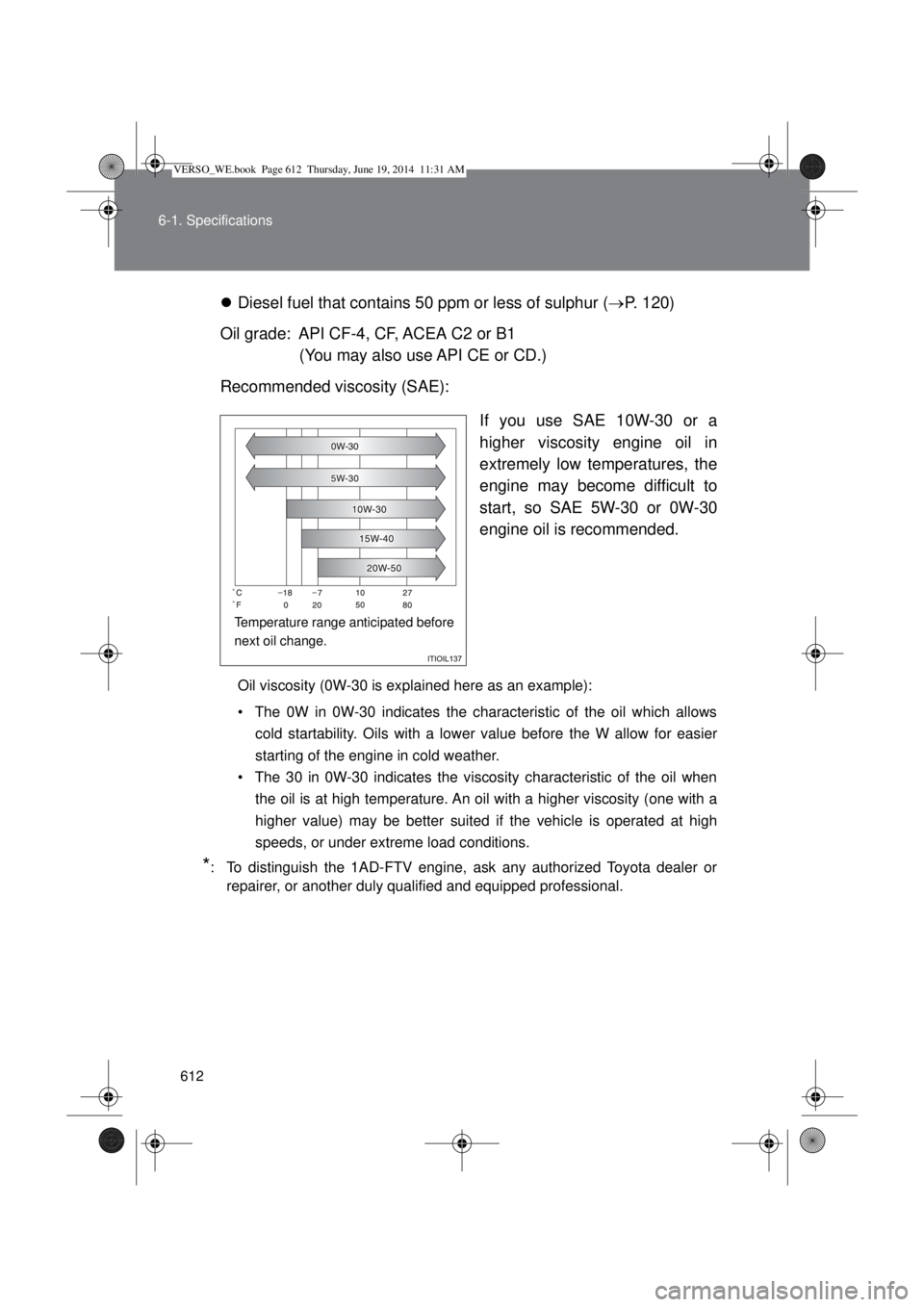
612 6-1. Specifications
Diesel fuel that contains 50 ppm or less of sulphur (P. 120)
Oil grade: API CF-4, CF, ACEA C2 or B1
(You may also use API CE or CD.)
Recommended viscosity (SAE):
If you use SAE 10W-30 or a
higher viscosity engine oil in
extremely low temperatures, the
engine may become difficult to
start, so SAE 5W-30 or 0W-30
engine oil is recommended.
Oil viscosity (0W-30 is explained here as an example):
• The 0W in 0W-30 indicates the characteristic of the oil which allows
cold startability. Oils with a lower value before the W allow for easier
starting of the engine in cold weather.
• The 30 in 0W-30 indicates the viscosity characteristic of the oil when
the oil is at high temperature. An oil with a higher viscosity (one with a
higher value) may be better suited if the vehicle is operated at high
speeds, or under extreme load conditions.
*: To distinguish the 1AD-FTV engine, ask any authorized Toyota dealer or
repairer, or another duly qualified and equipped professional.
Temperature range anticipated before
next oil change.
VERSO_WE.book Page 612 Thursday, June 19, 2014 11:31 AM
Page 613 of 650
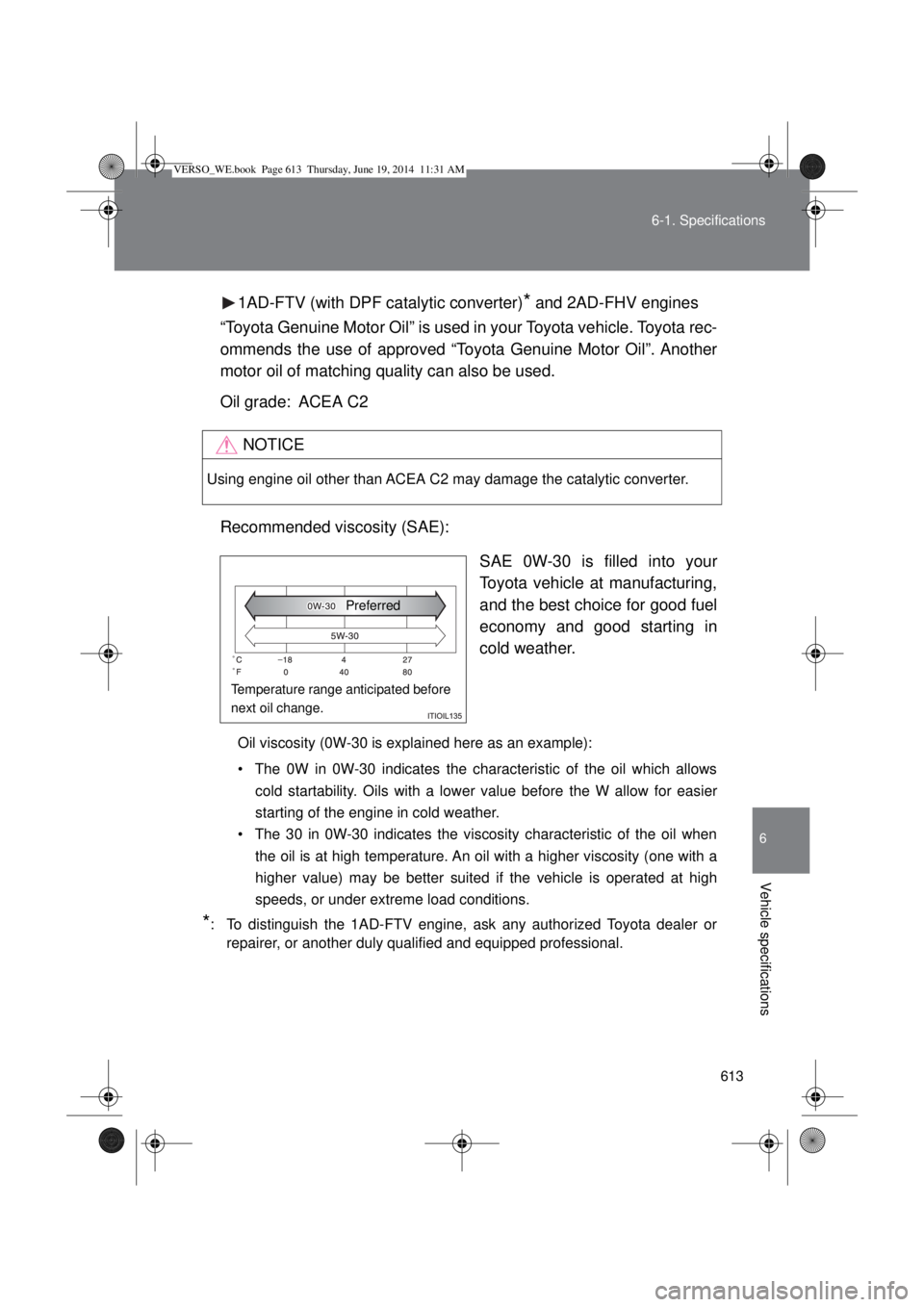
613 6-1. Specifications
6
Vehicle specifications
1AD-FTV (with DPF catalytic converter)* and 2AD-FHV engines
“Toyota Genuine Motor Oil” is used in your Toyota vehicle. Toyota rec-
ommends the use of approved “Toyota Genuine Motor Oil”. Another
motor oil of matching quality can also be used.
Oil grade: ACEA C2
Recommended viscosity (SAE):
SAE 0W-30 is filled into your
Toyota vehicle at manufacturing,
and the best choice for good fuel
economy and good starting in
cold weather.
Oil viscosity (0W-30 is explained here as an example):
• The 0W in 0W-30 indicates the characteristic of the oil which allows
cold startability. Oils with a lower value before the W allow for easier
starting of the engine in cold weather.
• The 30 in 0W-30 indicates the viscosity characteristic of the oil when
the oil is at high temperature. An oil with a higher viscosity (one with a
higher value) may be better suited if the vehicle is operated at high
speeds, or under extreme load conditions.
*: To distinguish the 1AD-FTV engine, ask any authorized Toyota dealer or
repairer, or another duly qualified and equipped professional.
NOTICE
Using engine oil other than ACEA C2 may damage the catalytic converter.
Temperature range anticipated before
next oil change.Preferred
VERSO_WE.book Page 613 Thursday, June 19, 2014 11:31 AM